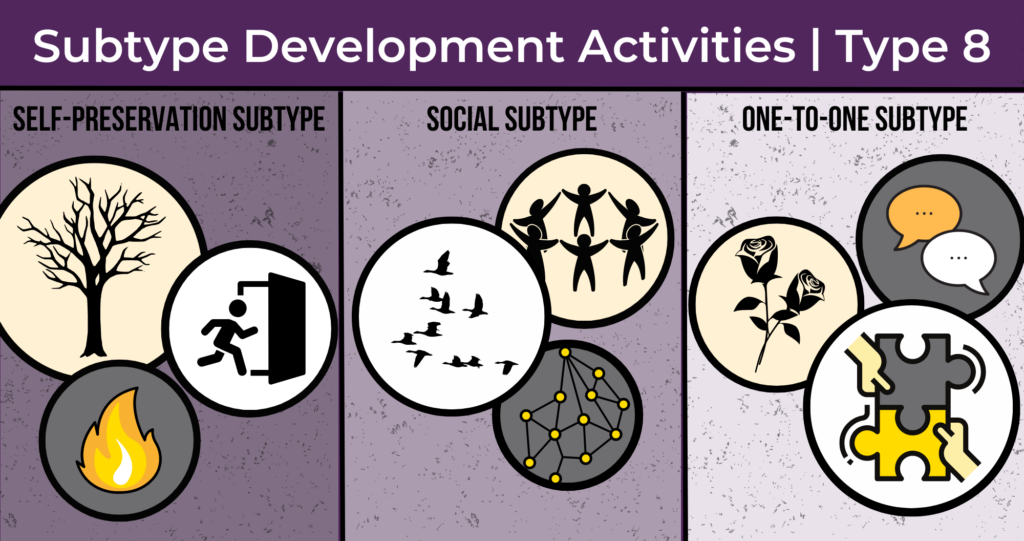There are three versions of each Enneagram type called subtypes: self-preserving subtype, social subtype and one-to-one subtype. Subtypes are formed when the emotional patterns or habits of our type, also called the type’s passion or vice, intersect and combine with one of the three basic human instincts, the instinct that is most activated within us: self-preservation instinct, social instinct or one-to-one instinct. We may have more than one activated instinct, so we could relate to two or even all three subtypes for our type.
Each instinct has specific focal areas. Individuals with that activated instinct, once it combines with the emotional pattern of our type, may move toward that instinctual area, away from that arena, or have ambivalence about that area. A way of understanding this is that the instincts by themselves are simply human and natural. However, when the activated instinct(s) combines with our type-based emotional pattern, the instinct then becomes distorted and, thus, less able to satisfy our natural needs in that instinctual area.
Here you can read about the passion or emotional habit of the type, a name for and a description of that subtype as it combines the emotional habit with that instinct, followed by one specific development idea that is particularly useful to people of that subtype. Please remember that we may have more than one active subtype, so the development activities for the additional subtype are also good for your development.
EIGHTS
Emotional pattern of LUST
Denying anxiety, sadness and vulnerability by engaging in a variety of self-satisfying behaviors and doing so in an excessive way
Self-preservation Eight subtypes
Self-Preservation Eights subtypes (“survival”) get what they think they need for survival, become highly frustrated, intolerant, and angry when the fulfillment of their needs are thwarted, are attuned to power and influence dynamics, and tend be quieter than the other two subtypes of Eight.
Self-preservation Eight subtype development
Notice your need to be strong, self-reliant and strategic; learn to strategize less and verbalize your needs and rely on others more.
One way to strategize less and verbalize your needs and rely on others more:
Consider this idea: Assess the kinds of physical stimulation you crave the most. What are they? How often do they occur? What factors, internal or external, activate them? Next, every time you are about to pursue the particular kinds of physical stimulation you crave, pause and ask yourself what you are really feeling.
Social Eight subtypes
Social Eight subtypes (“solidarity” ) vigorously protect others from unjust and unfair authorities and systems and challenge social norms, while also seeking power, influence, and pleasure.
Social Eight subtype development
Notice your need to be strong and to protect others; allow yourself to need and be supported by others.
One way to allow yourself to need and be supported by others:
Do you let others do things for you, support you, and get close to you? Can you share your sorrows and pain with others as well as your doubts and uncertainties? Your protectiveness may help you feel connected to others, but this is not real closeness or a substitute for true intimacy. Share more and you’ll feel more deeply connected to yourself and others.
One-to-One Eight subtypes
One-to-One Eight subtypes (“possession”) are rebellious, provocative, emotional, intense, and passionate, draw others to them and derive their power and influence from being at the center of events and the lives of others.
One-to-One Eight subtype development
Notice your need to provoke, to be potent, to possess the ones you love and to be at the center of and control everything if you can; manage your intensity and be both more present and pure.
One way to manage your intensity and be more present and pure:
Do you want all of something or someone you love or care about. This is what the word “possession” means. Although you may not think of your desires as possessive, those on the receiving end often do. To have more balanced and spacious relationships, relax your needs and actions when you start to want to have all of something or someone. Breathe and tell yourself this: “Let me give my desires and the other person more freedom and space.”
These activities are excerpts from the new additions to the soon-available 3rd edition of The Enneagram Development Guide, with over 60 development activities for each Enneagram type.
Ginger Lapid-Bogda PhD, author of nine Enneagram books, is a speaker, consultant, trainer, and coach. She provides certification programs and training tools for business professionals around the world who want to bring the Enneagram into organizations with high-impact business applications. TheEnneagramInBusiness.com | ginger@theenneagraminbusiness.com


Comments are closed.